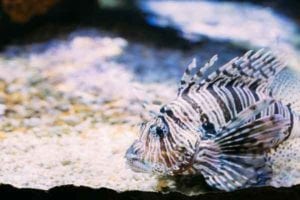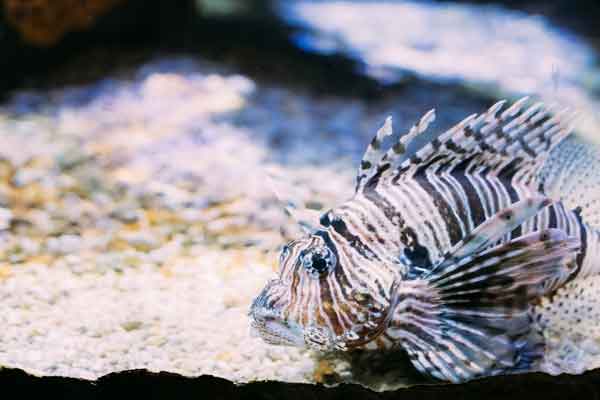Care Recommendations for Volitan Lionfish (Pterois volitans)
- Care Level: Easy
- Temperament: Semi-aggressive
- Color: Black, Red, White
- Diet: Carnivore
- Reef Compatible: With Caution
- Water Conditions: 72-78° F, dKH 8-12, pH 8.1-8.4, sg 1.021-1.023
- Max. Size: 1′ 3″
- Venomous: Yes
- Origin: Caribbean, Indonesia, Vanuatu
- Family: Scorpaenidae
- Minimum Tank Size: 120 gallons
Geographic Areas of the Volitan Lionfish

Physical Attributes of the Volitan Lionfish
One of the most visually stunning fish in the trade hardly looks like a fish at all. The Volitan Lionfish has long, multi-patterned, fan-like fins that seem to extend from every corner of its body. The tall banded spines that reach out from the dorsal fin can range anywhere between six and twelve, while the pectoral fins can reach out to nearly the length of the fish.
The colors can range from a reddish-brown to dark brown and white stripes extending the length of the body and face.
The spines on the dorsal, pelvic and anal fins are poisonous, but not deadly to humans. Spines are only used as defensive measures. If accidentally pricked, it feels similar to a strong bee sting.
The lionfish grows quickly and can reach sizes up to 15 inches.
Volitan Lionfish Molting
Over time various types of algae, hydroids, and bacteria can build up on the lionfish’s skin. They are slow swimmers and prone to periods of sedentary behavior so this can easily occur. As a way of protecting themselves, lionfish have developed a thin protective layer of skin which they eventually shed. This is also why this type of fish is fairly disease resistant.
This process can happen as frequently as each week. The skin layer is actually referred to as the cuticle and is not a mucous layer nor venom as it is sometimes thought to be.
Tank Conditions for the Volitan Lionfish
Good tankmates are said to be Snow Flake Eels and Large Hippo Tangs to name a few. More often, the determinant of whether or not the Volitan will get along with a fish is size. Anything that is roughly half its size and moving it will try to eat. They are considered to be one of the better predators in the trade. If you would like to house two lionfish it is better to make sure they are both similar in size and are introduced to the tank at the same time.
Tanks must be larger in size (120-gallon minimum) and ideally, have a good amount of crevassed rock work with a sandy substrate.
Diet/Feeding Requirements for Volitan Lionfish
The Volitan Lionfish seems to enjoy the thrill of the hunt. Instead of waiting for its prey to come close like most species, it will actively stalk its food before attacking. This may include smaller fish, shrimp or other crustaceans in the tank so be cautious.
When first introduced and while still acclimating to the aquarium it is recommended to feed live saltwater feeder shrimp and live fish to entice the fish to eat more. Once settled, you may switch over to a frozen diet of shrimp, silversides, squid, and krill. Juveniles should be fed every other day while adults can have a schedule of three times a week.
Learn more about caring for Lionfish

















